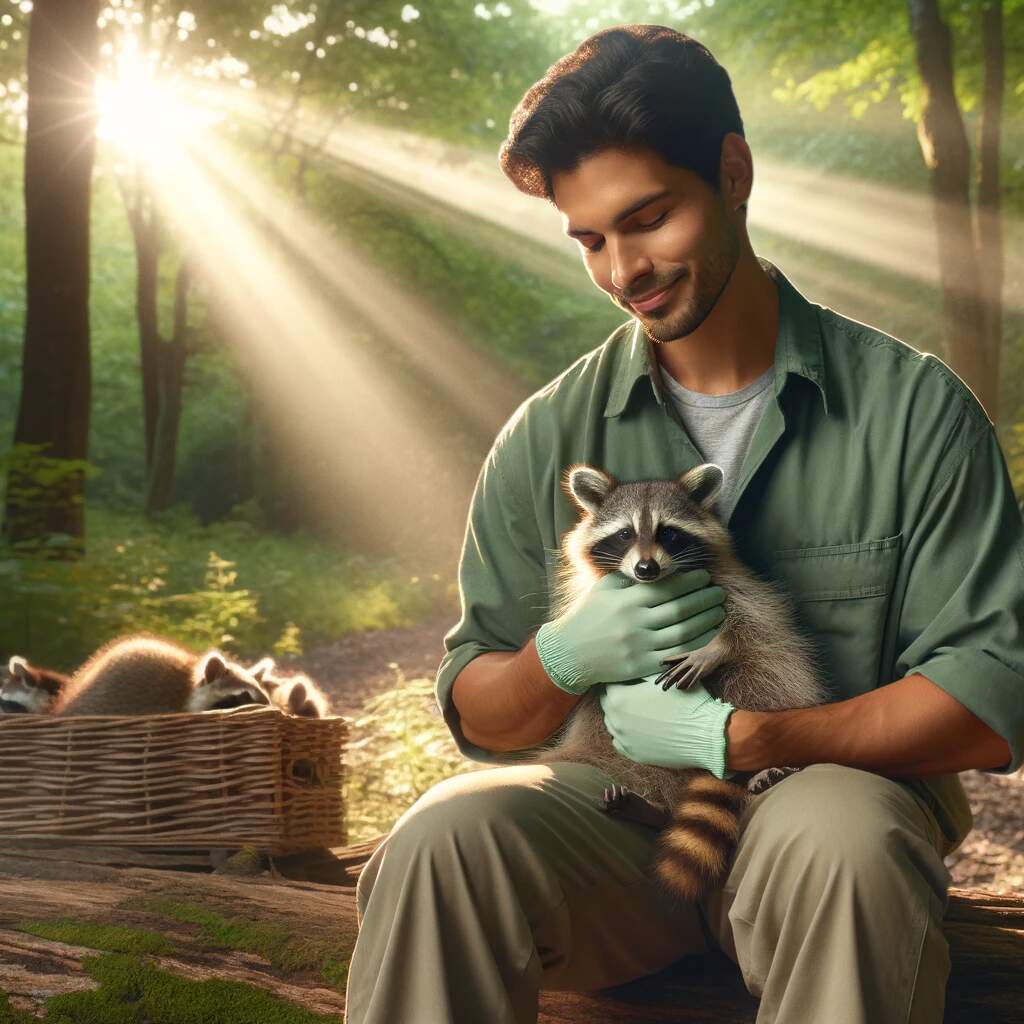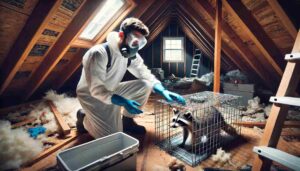Raccoons, known for their distinctive masked faces and nimble paws, have earned a reputation as both lovable and mischievous creatures. While we find them fascinating in the wild, these adaptable animals sometimes face precarious situations that require human intervention. Wildlife rescues play a vital role in rescuing and rehabilitating injured, orphaned, or distressed raccoons, offering them a second chance at life in the wild.
This article delves into the world of raccoon rehabilitation, exploring the challenges these animals encounter, the role of wildlife rescues, and the intricate process of preparing raccoons for release.
The Raccoon’s Plight
Raccoons, scientifically known as Procyon lotor, are native to North America and have a wide distribution, spanning from Canada to Panama. Their adaptability and omnivorous diet have made them highly successful urban wildlife, often cohabiting with humans in cities and suburbs. However, this close proximity can lead to numerous conflicts and challenges for raccoons.
- Human-Wildlife Conflict: Raccoons often rummage through garbage cans, raid gardens, and nest in attics, causing frustration for homeowners. In response, some people resort to harmful or lethal methods to remove raccoons from their properties.
- Injury and Disease: Raccoons face numerous risks in urban environments, including traffic accidents, injuries from encounters with domestic animals, and exposure to diseases like rabies and distemper.
- Orphaned Young: Young raccoons, or kits, may become separated from their mothers due to various reasons, such as the mother’s death, abandonment, or accidental separation during construction or landscaping activities.
- Environmental Hazards: Pollution, habitat destruction, and climate change further threaten raccoon populations, making it essential for humans to step in and provide assistance when needed.
The Role of Wildlife Rescues
Wildlife rescues, rehabilitation centers, and animal welfare organizations play a critical role in addressing the challenges faced by raccoons and other wildlife species. These organizations have trained professionals and volunteers who dedicate their time and expertise to caring for injured and orphaned animals. When it comes to raccoon rehabilitation, these organizations offer several vital services:
- Rescue and Transport: Wildlife rescues respond to calls from concerned citizens reporting injured or distressed raccoons. They capture and safely transport the animals to their facilities for assessment and treatment.
- Medical Care: Injured raccoons receive immediate medical attention. This may include treating wounds, setting broken bones, and administering medication for diseases or parasites.
- Nutritional Support: Orphaned kits require specialized care, as they are entirely dependent on their mother’s milk in their early weeks of life. Wildlife rehabilitators provide them with suitable milk substitutes and gradually transition them to solid foods as they grow.
- Socialization and Behavior Training: Young raccoons must learn vital survival skills, such as foraging and climbing. Rehabilitators create a semi-wild environment to foster these skills while minimizing human interaction.
- Release Preparation: As raccoons recover and grow, they gradually transition from captivity to outdoor enclosures where they can hone their natural instincts. This process prepares them for release back into the wild.
The Challenges of Raccoon Rehabilitation
Raccoon rehabilitation is a complex and labor-intensive process, presenting numerous challenges for wildlife rescues and rehabilitators.
- Zoonotic Diseases: Raccoons can carry diseases that are transmissible to humans, such as rabies and Baylisascaris procyonis (a roundworm). This requires careful handling and appropriate safety measures to protect both raccoons and humans.
- Stress and Human Interaction: Raccoons are highly sensitive to stress, and excessive human contact can hinder their ability to adapt to a wild environment. Rehabilitators must strike a delicate balance between care and minimizing interaction.
- Release Site Selection: Choosing an appropriate release site is crucial for the raccoon’s chances of survival. Rehabilitators must consider factors like habitat suitability, food availability, and the absence of potential hazards.
- Predation and Competition: Released raccoons face the challenges of predation by natural predators and competition with established raccoon populations. This underscores the importance of preparing them adequately for the wild.
- Long-Term Monitoring: Rehabilitators often lack the resources for long-term monitoring of released animals. Knowing the outcomes of rehabilitation efforts is essential for assessing success and refining techniques.
The Rehabilitation Process
The process of rehabilitating raccoons is intricate and requires a combination of veterinary care, behavioral training, and preparation for release.
- Initial Assessment: Upon arrival at a wildlife rescue center, each raccoon undergoes a thorough health assessment. This includes a physical examination, blood tests, and diagnostic imaging to identify any injuries or diseases.
- Treatment and Recovery: Injured raccoons receive immediate medical attention. Depending on the severity of their injuries, they may require surgery or wound care. Once stabilized, they are placed in quiet, low-stress environments to recover.
- Orphan Care: Orphaned kits are fed a specialized formula that mimics their mother’s milk. Rehabilitators ensure that they receive proper nutrition, grow at a healthy rate, and develop the skills needed for survival.
- Socialization and Skill Development: Young raccoons are provided with opportunities to explore and develop their natural behaviors. They are encouraged to climb, forage, and interact with objects that simulate the challenges they will face in the wild.
- Semi-Wild Enclosures: As raccoons grow and progress in their rehabilitation, they are moved to semi-wild enclosures. These enclosures offer a more natural environment with trees, dens, and access to a wider range of food sources.
- Release Conditioning: In preparation for release, raccoons are exposed to outdoor conditions gradually. This helps them acclimate to changes in weather, temperature, and natural sounds.
- Soft Release: Rehabilitators often employ a “soft release” technique, where raccoons are released in a controlled environment with supplemental food for a period. This gives them time to establish territories and forage skills before fully transitioning to independence.
- Post-Release Monitoring: When resources permit, some wildlife rescues engage in post-release monitoring. This may involve tracking raccoons using radio collars or other tracking methods to assess their survival and adaptation to the wild.
Success Stories in Raccoon Rehabilitation
Raccoon rehabilitation has yielded many success stories, demonstrating the positive impact of wildlife rescues and dedicated rehabilitators. Here are a few notable examples:
- The Tale of Rocky: Rocky, a young raccoon found abandoned in a suburban backyard, was brought to a wildlife rehabilitation center. After months of care and socialization, Rocky was successfully released back into a nearby nature reserve. His journey from vulnerability to independence was a testament to the rehabilitation process.
- Riley’s Resilience: Riley, a female raccoon, was hit by a car and suffered a severe leg injury. Thanks to the quick response of a wildlife rescue team, she received surgery to repair her leg. After a period of rehabilitation, Riley was released back into the wild, displaying remarkable resilience in adapting to her new environment.
- The Brookside Raccoon Family: An entire family of raccoons was orphaned when their mother was killed by a predator. The young kits were brought to a wildlife rehabilitation center, where they were nurtured and taught essential survival skills. Once matured, the family was released together, ensuring they had the support of their siblings in their new life in the wild.
The Ethical Dilemma of Raccoon Rehabilitation
While raccoon rehabilitation is undoubtedly a noble endeavor, it raises ethical questions and challenges. These dilemmas stem from the intersection of human intervention and the wild lives of these creatures.
- Dependency on Humans: Raccoons that are raised and rehabilitated by humans can become habituated to human presence and reliant on provided food. This dependency can hinder their ability to forage and fend for themselves in the wild.
- Disease Transmission: Raccoons, like all wild animals, carry diseases that can be transmitted to humans and domestic animals. Rehabilitation centers must implement strict hygiene protocols to minimize the risk of disease transmission.
- Predation and Competition: Releasing rehabilitated raccoons into established populations may disrupt local ecosystems, increase competition for resources, and expose them to predation by natural predators.
- Resource Allocation: Wildlife rescues have limited resources, and rehabilitating raccoons can be resource-intensive. This allocation of resources to individual animals must be balanced with the broader conservation needs of wildlife species.
- End-of-Life Decisions: In some cases, raccoons may have injuries or health conditions that cannot be fully remedied. Wildlife rehabilitators face difficult decisions about the quality of life and the potential for release in such cases.
To address these ethical concerns, wildlife rehabilitators and conservationists continually assess and refine their practices, seeking the best possible outcomes for the animals in their care while considering the broader ecological impact.
The Importance of Public Awareness and Education
Raccoon rehabilitation is not only about rescuing and caring for individual animals but also about raising public awareness and fostering a sense of responsibility towards wildlife. Education plays a vital role in this process:
- Raising Awareness: Wildlife rescues often engage in public outreach efforts, including school programs, community events, and online content, to educate people about raccoons and the importance of coexisting with them peacefully.
- Preventing Conflicts: By providing information on how to prevent raccoon-human conflicts (e.g., securing garbage cans, removing potential den sites), rehabilitators can help reduce the number of raccoons requiring rescue.
- Reporting Injured Wildlife: Educating the public about the importance of reporting injured or distressed wildlife promptly can lead to faster response times and better outcomes for animals in need.
- Responsible Feeding Practices: Discouraging the feeding of raccoons and other wildlife can prevent them from becoming dependent on human-provided food sources.
- Conservation Messages: Wildlife rescues often use the stories of rehabilitated raccoons to convey broader conservation messages about the importance of preserving natural habitats and protecting native wildlife.
Conclusion
Raccoon rehabilitation is a multifaceted endeavor that combines veterinary care, behavioral training, and a commitment to giving these creatures a second chance in the wild. Wildlife rescues and rehabilitators play a vital role in addressing the challenges faced by raccoons, from human-wildlife conflicts to injuries and orphaned young. Success stories of raccoon rehabilitation exemplify the positive impact of these efforts, showcasing the resilience and adaptability of these creatures.
However, the ethical dilemmas surrounding raccoon rehabilitation remind us of the complexities involved in human intervention in the lives of wild animals. Striking a balance between individual animal welfare and ecological considerations requires careful thought and ongoing reflection.
Ultimately, raccoon rehabilitation serves as a powerful reminder of our responsibility as stewards of the natural world. By raising public awareness, fostering a sense of coexistence, and supporting wildlife rescues, we can contribute to the well-being of raccoons and other wildlife species that share our urban and wild landscapes. In doing so, we can ensure that future generations have the opportunity to admire these clever and adaptable creatures in their natural habitats.










